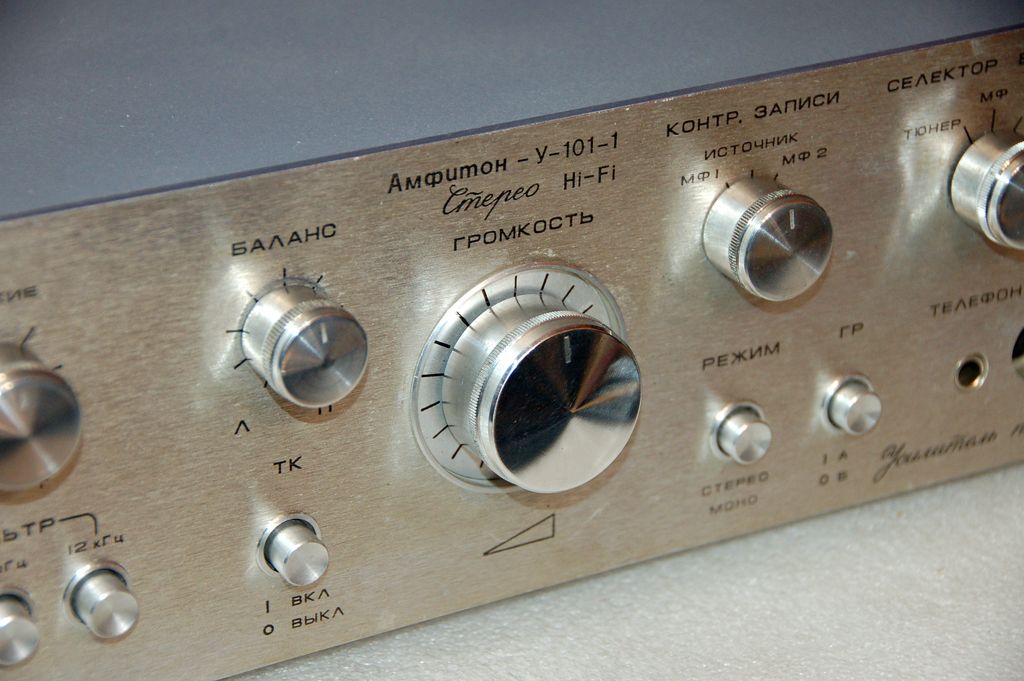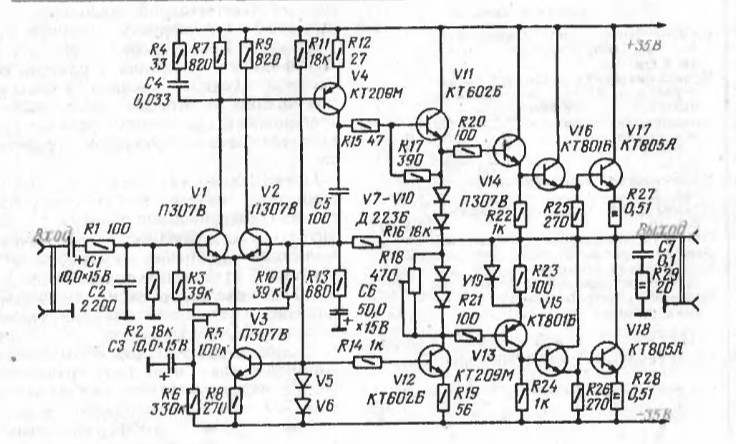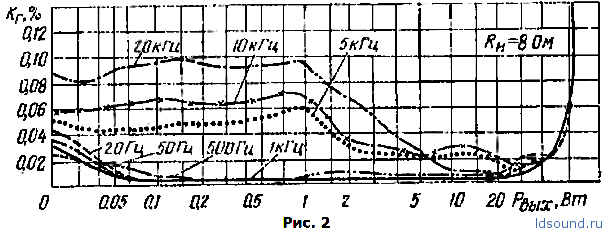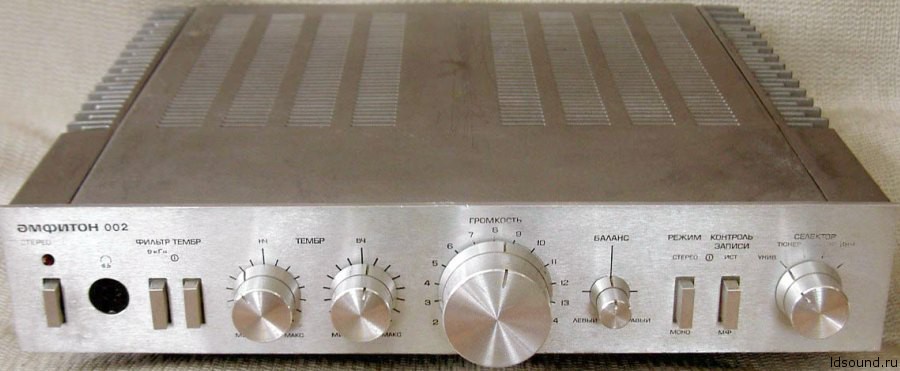Soviet HI-FI and its creators: Shushurin - Lamm - the author of the national amplifier and the hero of the American High End
In one of the articles in the “legendary amplifiers” series, I mentioned Vladimir (Shushurin) Lamma and his lamp UMZCH Lamm ml 2.1, which caused an irritated reaction from some lovers of “warm lammness”. The reason for the indignation of fans of the engineer was my criticism of the characteristics of the amplifier. In fairness, it should be noted that Shushurin (now Lamm) is known not only because of this device. His contribution to the development of amplifying equipment is disproportionately more than the creation of one controversial tube legend. For radio amateurs of the Land of Soviets, his name for a long time meant, perhaps, even more than for “tube” audiophiles today.

The fact is that Vladimir Shushurin was the author of one of the first Soviet UHF stereo stereo schemes suitable for the HI-FI standard (published in the magazine Radio in 1978). Numerous readers of this magazine had the opportunity to independently create such an amplifier during the years of total deficit of high-quality equipment in the USSR. The thousands of army of Soviet radio amateurs reproduced this scheme, and also created countless variations on the UMZCH Shushurin theme. In the 1980s, being the head of the Lviv Special Design Bureau for Household Appliances, Vladimir realized several serial models of HI-FI amplifiers, which were manufactured under the brand name “Amfiton”.
Volodymyr Shushurin received an engineering education of high quality by Soviet standards at the Lviv Polytechnic Institute, which at that time was considered one of the personnel forges of the Soviet military industry. The author of cult amplifiers finished his studies at the Faculty of Electrophysics in 1968 and received the specialty “Developer of semiconductor devices”.
Interestingly, the topic of Shushurin's thesis was far from amplifying devices and, in principle, from electroacoustics, and it concerned electroluminescence. In an interview, Shushurin said that he managed to complete the diploma 5 months before his defense. The high level of Shushurin’s training is evidenced by the fact that he passed his undergraduate practice at the Kiev Academy of Sciences, which was not possible for every Soviet student.
After completing the training, Shushurin planned to remain in Kiev and engage in scientific work, write a candidate’s, but unexpectedly fell into the Soviet Army. Having repaid the debt to his homeland, the engineer discovered that they managed to take warm places in Kiev and returned to Lviv, where he began his career at the Lvov Television Factory. In addition to televisions, this company actively worked in the defense industry.
According to the engineer, at the television factory he participated in the development of equipment for the MCC in Podlipkah, as well as aircraft simulators for training military and civilian pilots. Vladimir also said that during this period they managed to realize a television system with electronic scaling 40 times, which was a kind of record for television special equipment in the USSR at that time.
In the late 70s, Shushurin leaves the Lviv Television Factory and is the chief designer of the Lviv Special Design Bureau of household equipment. At about the same time (1978 year), his first publication appeared in the number 6 of the magazine “Radio”, where he first describes his HI-FI amplifier circuit.
The 1978 scheme was not devoid of a number of drawbacks, but was simple to implement. Relatively available radio elements were used for the amplifier.

In 1980, the editorial board of Radio magazine concluded that the Shushurin amplifier was one of the most popular designs in the amateur radio environment. This was evidenced by the editorial mail edition. Due to numerous requests, Shushurin published another version of the scheme, adapted for more modern and sophisticated radio components.
Characteristics of the device for the 1980th were truly unique. Virtually no serial amplifier in the USSR at that time allowed such a low level of harmonic distortion to be obtained.

Not impressed with such characteristics is difficult today.
In parallel, working in the Lvov Special Design Bureau of Household Appliances, Shushurin uses his talents to create serial amplifiers, the release of which begins in Lviv-BPO. Lenin. Under his leadership, the AMFITON A1-01-2u stereo 1982, the AMFITON-U-101-1 stereo 1982, the AMFITON-AI-01-1 stereo 1982 were created.


AMFITON-U-002 Hi-Fi stereo of 1983 is considered to be a real masterpiece of Soviet electronics. The characteristics of this device deserve special mention:


The technical features of these UMZCH include stabilized power sources, the absence of interstage capacitors in the pre-amplification paths, the use of film interstage capacitors at the input (not everywhere), the use of operational amplifiers with output voltage rise rates of 20 V / μs.
Almost all amplifiers created under the leadership of Shushurin were distinguished by a low level of nonlinear distortion. In this regard, and also because of the comparative availability and reasonable prices, these amplifiers have become one of the most popular in the Soviet Union.
At the beginning of the 1990s unsuccessful for the post-Soviet space of the 1990s, Vladimir Shushurin, like many talented engineers, decided to try his luck in the United States. When emigrating in 1987, he changed his last name. Interestingly, Lamm is not made-up (assigned), but the real name of Vladimir. Shushurin he was forced. His mother was afraid of problems with Jewish origin, which often occurred in the 40s (“the case of doctors”, anti-Semitic sentiments among the political elite of the USSR) and changed the name of her son.
In the country of the "victorious" American dream, he also decided to direct his energy towards the creation of amplifiers. In 1990, Vladimir began to cooperate with the New York company Madison Fielding. Due to the lack of understanding of some of the ideas of the engineer, his uncompromising approach to the implementation of his concepts, and also due to the arrogant attitude of partners as an “upstart immigrant”, Lamm ceased cooperation in 1993. Vladimir's developments did not go into the series, but remained only exhibition prototypes.

Vladimir Lamm (Shushurin) - 2013
In the same year of 1993, with the support of a suddenly wealthy acquaintance, Lamm opened his own company, Lamm Industries, and began the production of tube and hybrid amplifiers. Virtually everything that an engineer does today is designed for a high end audience. A number of vehicles are positioned as reference UMZCH. Such amplifiers are made according to the original hybrid scheme (US Patents D368,261 and No. 5477095). The latter surpass the classic “warm lamp” in formal (in Lamma terms) characteristics.
Pricing is based on the classic prestigious pricing strategy and the creator’s personal conclusions about the conformity of a device to its subjective notions about the quality of reproduction.
In the Soviet period, Vladimir Lamm spent a lot of time on psychoacoustic experiments and derived for himself the subjective quality criteria of sound reproducing apparatus. Despite the controversial nature of his conclusions, some of his experiments deserve special mention. So in an interview, he told the following:
But there was no definitive answer in the interview. Meanwhile, such phenomena, among other things with blind tests, are noted by a certain number of listeners - this may indicate that Lamma’s ambiguous views on sound have some grounds.
At the same time, the developer is firmly convinced that truly high-quality sound can only be analog, and digital processing does not in the best way affect fidelity.
The quote of Vladimir Lamma is borrowed from the material mybiz.ru "Eminent capitalism"
Also, according to Vladimir, only an engineer who has significant experience as a musician or as a listener to live concerts can create truly high-quality equipment. Such statements often cause skepticism and criticism of fellow developers, as well as people who approach the notion of “faithfulness of reproduction” from the traditional standpoint of dry parametric objectivism.
You can have different attitudes to the ideas of Vladimir Lamma about the sound quality and his concepts of creating UMZCH. Moreover, his contribution to the creation of mass Soviet Hi-Fi technology in the 80s of the last century is obvious. In addition, it is impossible not to pay tribute to the organizational and commercial talents of the engineer. It’s not for everyone to create their own production company from scratch and find their market (being a Soviet émigré in the USA in the 90s).
Jeans and links
A wide range of amplifiers , receivers and other sound-reproducing equipment is presented in our catalog . You can purchase both transistor and lamp UMZCH as well as high fidelity speaker systems from us .
In the post used photographic materials of the following resources:
hi-fidelity-forum.com
mybiz.ru
www.lammindustries.com
ldsound.ru
vega-brz.ru
www.theabsolutesound.com

The fact is that Vladimir Shushurin was the author of one of the first Soviet UHF stereo stereo schemes suitable for the HI-FI standard (published in the magazine Radio in 1978). Numerous readers of this magazine had the opportunity to independently create such an amplifier during the years of total deficit of high-quality equipment in the USSR. The thousands of army of Soviet radio amateurs reproduced this scheme, and also created countless variations on the UMZCH Shushurin theme. In the 1980s, being the head of the Lviv Special Design Bureau for Household Appliances, Vladimir realized several serial models of HI-FI amplifiers, which were manufactured under the brand name “Amfiton”.
Engineer way
Volodymyr Shushurin received an engineering education of high quality by Soviet standards at the Lviv Polytechnic Institute, which at that time was considered one of the personnel forges of the Soviet military industry. The author of cult amplifiers finished his studies at the Faculty of Electrophysics in 1968 and received the specialty “Developer of semiconductor devices”.
Interestingly, the topic of Shushurin's thesis was far from amplifying devices and, in principle, from electroacoustics, and it concerned electroluminescence. In an interview, Shushurin said that he managed to complete the diploma 5 months before his defense. The high level of Shushurin’s training is evidenced by the fact that he passed his undergraduate practice at the Kiev Academy of Sciences, which was not possible for every Soviet student.
After completing the training, Shushurin planned to remain in Kiev and engage in scientific work, write a candidate’s, but unexpectedly fell into the Soviet Army. Having repaid the debt to his homeland, the engineer discovered that they managed to take warm places in Kiev and returned to Lviv, where he began his career at the Lvov Television Factory. In addition to televisions, this company actively worked in the defense industry.
According to the engineer, at the television factory he participated in the development of equipment for the MCC in Podlipkah, as well as aircraft simulators for training military and civilian pilots. Vladimir also said that during this period they managed to realize a television system with electronic scaling 40 times, which was a kind of record for television special equipment in the USSR at that time.
Rising star of the Soviet amplification
In the late 70s, Shushurin leaves the Lviv Television Factory and is the chief designer of the Lviv Special Design Bureau of household equipment. At about the same time (1978 year), his first publication appeared in the number 6 of the magazine “Radio”, where he first describes his HI-FI amplifier circuit.
The 1978 scheme was not devoid of a number of drawbacks, but was simple to implement. Relatively available radio elements were used for the amplifier.

In 1980, the editorial board of Radio magazine concluded that the Shushurin amplifier was one of the most popular designs in the amateur radio environment. This was evidenced by the editorial mail edition. Due to numerous requests, Shushurin published another version of the scheme, adapted for more modern and sophisticated radio components.
Characteristics of the device for the 1980th were truly unique. Virtually no serial amplifier in the USSR at that time allowed such a low level of harmonic distortion to be obtained.

Rated output power, at a load of 4 ohms: 2x70 watts.
Nominal frequency range: from 15 to 25 000 Hz.
Irregularity of the frequency response (at a frequency of 1000 Hz): ± 0.5 dB.
Harmonic Coefficient:
20 Hz - 0.03%;
1000 - 0.015%;
20,000 - 0.045%;
The coefficient of intermodulation distortion, with a ratio of amplitudes of signals with a frequency of 250 and 8000 Hz: not more than 0.1%
Relative interference level: -78 dB
Input resistance: 16 kΩ
Output impedance (at a frequency of 1000 Hz): 0.07 ohm
Damping factor with a load of 8 ohms: 58 dB
Power consumption: 72 W
Not impressed with such characteristics is difficult today.
In parallel, working in the Lvov Special Design Bureau of Household Appliances, Shushurin uses his talents to create serial amplifiers, the release of which begins in Lviv-BPO. Lenin. Under his leadership, the AMFITON A1-01-2u stereo 1982, the AMFITON-U-101-1 stereo 1982, the AMFITON-AI-01-1 stereo 1982 were created.


AMFITON-U-002 Hi-Fi stereo of 1983 is considered to be a real masterpiece of Soviet electronics. The characteristics of this device deserve special mention:
Frequency range: 20 - 25000 Hz.
Irregularity of the frequency response in the range of 20-25000 Hz: ± 0.7 dB.
Resistance of the connected speakers: 4 ohms.
Output power per channel:
rated: 25 watts;
maximum: 100 watts;
Headphones (nominal): 0.1 W / 120 ohm;
Harmonic coefficient in the range of 40-16000 Hz: 0.13%
Harmonic coefficient at a frequency of 1000 Hz: 0.07%
Total nonlinear distortion: 0.25%
Damping ratio: 20 times.
Transient attenuation between channels at a frequency:
250 Hz and 10,000 Hz: 38 dB;
1000 Hz: 48 dB;
Signal-to-noise ratio at nominal input conditions:
Linear MF and TUNER: 83 dB;
corrective ES: 72 dB;
The difference in channel gain in the range of 250-630 Hz: 1.5 dB.
Loudness at -40 dB at a frequency of 63 Hz relative to 1000 Hz: +10 dB.
Power consumption: 105 watts.
The size of the amplifier (WxHxD): 387x88x390 mm.
Amplifier weight: 9 kg.
The content of precious metals:
gold: 0.12 g;
silver: 0.3 g


The technical features of these UMZCH include stabilized power sources, the absence of interstage capacitors in the pre-amplification paths, the use of film interstage capacitors at the input (not everywhere), the use of operational amplifiers with output voltage rise rates of 20 V / μs.
Almost all amplifiers created under the leadership of Shushurin were distinguished by a low level of nonlinear distortion. In this regard, and also because of the comparative availability and reasonable prices, these amplifiers have become one of the most popular in the Soviet Union.
From Shushurin to Lamm
At the beginning of the 1990s unsuccessful for the post-Soviet space of the 1990s, Vladimir Shushurin, like many talented engineers, decided to try his luck in the United States. When emigrating in 1987, he changed his last name. Interestingly, Lamm is not made-up (assigned), but the real name of Vladimir. Shushurin he was forced. His mother was afraid of problems with Jewish origin, which often occurred in the 40s (“the case of doctors”, anti-Semitic sentiments among the political elite of the USSR) and changed the name of her son.
In the country of the "victorious" American dream, he also decided to direct his energy towards the creation of amplifiers. In 1990, Vladimir began to cooperate with the New York company Madison Fielding. Due to the lack of understanding of some of the ideas of the engineer, his uncompromising approach to the implementation of his concepts, and also due to the arrogant attitude of partners as an “upstart immigrant”, Lamm ceased cooperation in 1993. Vladimir's developments did not go into the series, but remained only exhibition prototypes.

Vladimir Lamm (Shushurin) - 2013
In the same year of 1993, with the support of a suddenly wealthy acquaintance, Lamm opened his own company, Lamm Industries, and began the production of tube and hybrid amplifiers. Virtually everything that an engineer does today is designed for a high end audience. A number of vehicles are positioned as reference UMZCH. Such amplifiers are made according to the original hybrid scheme (US Patents D368,261 and No. 5477095). The latter surpass the classic “warm lamp” in formal (in Lamma terms) characteristics.
Pricing is based on the classic prestigious pricing strategy and the creator’s personal conclusions about the conformity of a device to its subjective notions about the quality of reproduction.
Lamm subjectivism
In the Soviet period, Vladimir Lamm spent a lot of time on psychoacoustic experiments and derived for himself the subjective quality criteria of sound reproducing apparatus. Despite the controversial nature of his conclusions, some of his experiments deserve special mention. So in an interview, he told the following:
“We have three amplifiers: one has 1–2% distortion, the other has 0.1% distortion, and the third has thousandths of a percent. We listen to all this through a speaker system that has 5% distortion. Theoretically, we should not hear the difference - only the handwriting of the speaker system. But we hear perfectly well that the amplifiers sound differently. Paradox, right? The answer to this question is not so easy to find. It took me several years to figure out how to answer it. “
But there was no definitive answer in the interview. Meanwhile, such phenomena, among other things with blind tests, are noted by a certain number of listeners - this may indicate that Lamma’s ambiguous views on sound have some grounds.
At the same time, the developer is firmly convinced that truly high-quality sound can only be analog, and digital processing does not in the best way affect fidelity.
“The digital sound, consisting of fragments-bits, is actually not real. Each of us subconsciously rejects it, despite the prevalence and familiarity of the "numbers". A real sound is capable of transmitting only a “lamp”, which does not know how to divide it into fragments, but delivers it as it is. ”
The quote of Vladimir Lamma is borrowed from the material mybiz.ru "Eminent capitalism"
Also, according to Vladimir, only an engineer who has significant experience as a musician or as a listener to live concerts can create truly high-quality equipment. Such statements often cause skepticism and criticism of fellow developers, as well as people who approach the notion of “faithfulness of reproduction” from the traditional standpoint of dry parametric objectivism.
Total
You can have different attitudes to the ideas of Vladimir Lamma about the sound quality and his concepts of creating UMZCH. Moreover, his contribution to the creation of mass Soviet Hi-Fi technology in the 80s of the last century is obvious. In addition, it is impossible not to pay tribute to the organizational and commercial talents of the engineer. It’s not for everyone to create their own production company from scratch and find their market (being a Soviet émigré in the USA in the 90s).
Jeans and links
A wide range of amplifiers , receivers and other sound-reproducing equipment is presented in our catalog . You can purchase both transistor and lamp UMZCH as well as high fidelity speaker systems from us .
In the post used photographic materials of the following resources:
hi-fidelity-forum.com
mybiz.ru
www.lammindustries.com
ldsound.ru
vega-brz.ru
www.theabsolutesound.com
All Articles